The Umtali Museum

(a unit of The National Museums and Monuments of Rhodesia.)
Other units of the
NATIONAL MUSEUMS AND MONUMENTS OF RHODESIA
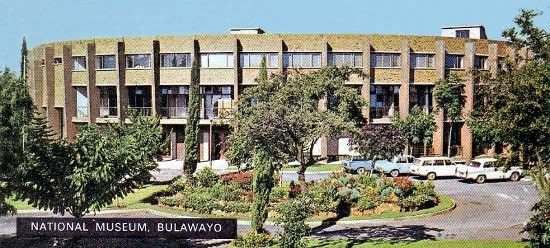
The National Museum, Centenary Park. Bulawayo.
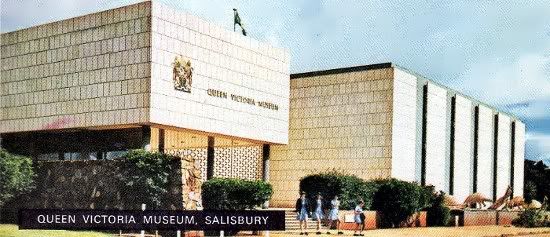
The Queen Victoria Museum. Civic Centre, Salisbury
(For Monuments section see the Inside of the back cover.)
INTRODUCTION
THE UMTALI MUSEUM AND THE MUSEUM SOCIETY
It is a constant source of satisfaction and pride to read the comments in the visitors' book and to hear the remarks made as parties tour the display galleries of the Umtali Museum. To many, particularly those from abroad, it comes as something of a surprise that a place with a total population of less than 55 000 should boast a museum at all and a very fine one at that. It is interesting to note in passing that the display space in the Umtali Museum equals that of the Queen Victoria Museum in Salisbury, our capital city. The building is a credit to the National Museums and Monuments of Rhodesia and is tangible evidence of the wisdom of placing all museums within the country under the control of a single national organisation. The Umtali Museum is a regional museum in concept, covering the eastern districts of Rhodesia that are known collectively as Manicaland.
The history of the Umtali Museum is set out in pictorial fashion in the pages that follow. A reading of the accompanying text will reveal that the history of the Museum is inextricably interwoven with that of the Umtali Museum Society. Indeed, it is safe to say that the Museum owes its very existence to the Museum Society. It was the Society that accumulated and displayed the first collections of historical and natural objects, that persuaded the Municipality to provide a temporary home for the museum and that finally got Government to accept responsibility for a new permanent museum. The Umtali Museum Society came into being as a committee of the Southern Rhodesia Hunters and Game Preservation Association in October 1953, the Society being formally established in August of the following year for the purpose of "inaugurating and fostering interest in the establishment of a museum in Umtali". Within a decade the present Museum building and most of its displays were open to the public; this was no mean achievement! Umtali will always be deeply indebted to the members of the Museum Society for their foresight and energy, and to no one more so than to their Honorary Curator, the late Captain E. F. Boultbee.
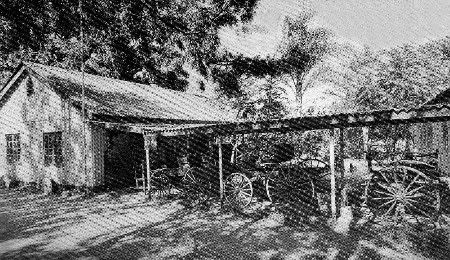
On the 1st November, 1957, the Municipality of Umtali made available to the Museum Society the dining-room and kitchen section of the old Silver Oaks Hostel just above the present Museum site. This gave the Society the opportunity to exhibit the collections which it then possessed. (Photo: Windsor Studios)
Having achieved its primary objective, the Museum Society could have been forgiven had it then rested on its laurels and left the development of the new museum to the authorities. However, far from retiring from the scene, the Society h^s for the past twenty years continued to play an active part in the life of the Museum. Members have helped to set up some of the new displays and have continued to add material to the Museum collections. Perhaps the most significant contribution made by the Society has been in the field of public relations. The Museum staff has until recently been very small and has been fully committed, almost over-extended, in developing the displays and in organising and maintaining the collections. There was no time to become involved more than superficially with the public. It was left to the Museum Society to bridge the gap, to maintain public interest at a high level. This it has done admirably by arranging lectures, slide shows, demonstrations, films, open days and excursions, and by regularly publishing a newsletter. These activities have covered every conceivable field of natural, scientific and cultural history, and attendances have always been high.
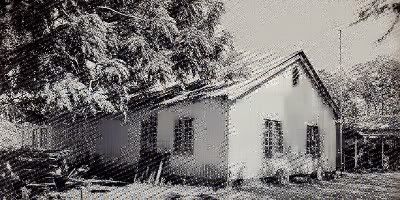
Another view of the old Museum at Silver Oaks. (Photo: Windsor Studios)
Now the Umtali Museum has developed to a point where greater public involvement is feasible and so it has assumed the mantle which the Society has worn for so long. The Museum itself is now running theMuseum Society. The general aims and objects remain as before but there is a greater emphasis on the role of the Society in relation to the other scientific and cultural societies in the city. The Museum Society serves as a parent body to which the other societies are affiliated. It publishes a monthly newsletter covering the activities of all the societies and assists them with certain clerical duties. It provides a programme of lectures and slide or film shows in those fields not served by specialist societies. It assesses the latent interest in these fields and when appropriate stimulates the formation of new societies to cover them. In this way it acts as a liaison between the various societies and augments the work that they are doing. The organisation and management of the Umtali Museum Society and the publication of the monthly newsletter are carried out by Museum staff as part of their routine duties.
What is a museum? One small Oxford dictionary defines it as "a building in which objects illustrating art or science are kept for show". Surely there is more to it than that I Webster's dictionary says a museum is "an institution for collecting, preparing, and exhibiting rare, interesting, or typical specimens of works of art, science, invention, manufacture, etc., or of antiquities, curiosities, or objects of natural history". This seems to be simply a longwinded version of the first definition and still suggests something moribund if not actually dead. Ask the average citizen to define a museum and at least one of the following words will appear: "dusty" "old", "fossil", "gloomy", "stuffed". Yet the modern museum is a bright, cheerful, vibrant place, full of life.
The word "museum" is derived from the Greek "mouseion", a place for the Muses or for study. The Muses of classical mythology were the daughters of Zeus and Mnemosyne, nine beautiful young goddesses distinguished as the protectresses of the arts. A mouseion was the meeting place of the Muses. I would like to think of the modern museum as the meeting place of the modern muses, a place where Man can muse, contemplate, ponder, meditate, wonder, study, think and communicate. I visualise the Umtali Museum as the focal point of the scientific and cultural activities of the city. Whether these activities are carried out in the quiet solitude of a single mind or in the stimulating presence of a group intellect, the Museum will provide the facilities. This is no ivory tower; this is a living museum. It was created by the community; it belongs to the community; it is our intention that the community should make maximum use of it.
The newsletter has established a regular means of communication between the Museum and the community and between the various societies within the community. The next facility to be provided will be a Lecture Hall with all the necessary aids such as projectors, epidiascope and so on. This should be achieved by the end of 1974. Finally it is hoped to build a Cultural Centre next to the Lecture Hall for use by the scientific and cultural societies. This will provide them with a permanent home where they can pursue their activities as an integral part of the Umtali Museum complex.
Curator, Umtali Museum
HISTORY OF THE UMTALI MUSEUM
Donald G. Broadley
Assistant Curator. Umtali Museum
THE idea of a Museum for Umtali seems to have been originated on the 22nd October, 1953, at an Annual General Meeting of the Manicaland Branch of the Southern Rhodesia Hunters and Game Preservation Association, when a sub-committee was set up to investigate the possibility of the establishment of a Museum in Umtali. This sub-committee met on 3rd November, 1953, and Captain E. F. (Ned) Boultbee was appointed Honorary Curator. From this date he started collecting exhibits for the proposed Museum. Early in 1954 Councillor H. T. F. Went offered the use of the old Fairbridge homestead "Utopia" to accommodate the collection of exhibits, but Captain Boultbee considered these premises unsuitable because of the difficulty in providing security, the limited space available and the distance from the centre of Umtali.
On 20th August, 1954, a public meeting "to inaugurate and foster interest in the establishment of a Museum in Umtali was held in the Drill Hall under the chairmanship of B. D. Goldberg Esq., M.P. This meeting led to the establishment of the Umtali Museum Society, with Sir Edgar Whitehead, K.C.M.G., O.B.E., as President and A. C. Soffe Esq., C.B.E., as Vice-President. Mr. Guthrie Hall became the first Chairman of the Museum Society Committee. An exhibition of the Museum Society's collections was held in an empty showroom in Main Street, Umtali, from 7th to 15th January, 1956. This was well attended and stimulated public interest in the proposed Museum.
On the 1st November, 1957, the Municipality of Umtali made available to the Museum Society the dining-room and kitchen section of the old Silver Oaks Hostel, a wood and corrugated iron building in Victory Avenue just above the present Museum site. This gave the Society the opportunity to exhibit, on a semi- permanent basis, the collections which it then possessed.
The displays at the Museum were naturally strongly influenced by the principal interests of the Hon. Curator, whose major contribution was the magnificent collection of pistols which he had brought out to Rhodesia from England. This collection was augmented by specimens obtained in Rhodesia and some valuable exhibits on loan. A comprehensive collection of animal-drawn transport was displayed on a covered walk-way at the front of the building. A wide variety of historical and ethnographical material was exhibited.
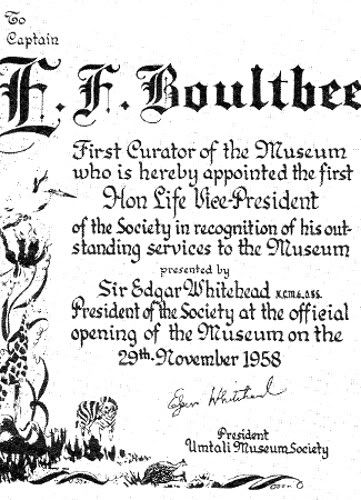
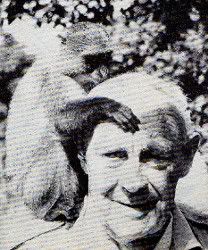
Captain E. F. Boultbee, first Curator of Umtali Museum, shown with one of his pet Samango Monkeys.
The principal zoological collection on display was the P. A. Sheppard collection of Manicaland butterflies and large moths (Hawk Moths and Saturnids), which had been purchased by the Umtali Municipality and was made available to the Umtali Museum Society on indefinite loan. A case of Manicaland birds was pre- pared by the Technical Department of the National Museum, Bulawayo, and that institution also donated old mounts of Roan and Sable Antelopes. A good selection of game heads was on display, in addition to a fine pair of elephant tusks lent by Mr. N. W. Methuen. A collection of skulls of large game was donated by Mr. Bredenkamp of the Game Department.
Captain Boultbee maintained a collection of live Samango and Vervet Monkeys (and later a Spotted Hyaena) in the grounds of the Museum.
By mid-1958, some 500 persons of all races were visiting the Museum each month, but the Society had no funds for development and was hard pressed to maintain it. In August, 1958, the Museum Society approached the Trustees of the National Museums of Southern Rhodesia to ask if they would be prepared to take over the Museum. Negotiations to this end were opened between the Society and the Southern Rhodesia Government on the advice of the Trustees. On 29th November, 1958, Sir Edgar Whitehead officially opened the Umtali Museum, making his address from a trek wagon.
At a meeting held on 31st August, 1959, the Trustees of the National Museums formally agreed to take over Umtali Museum as the third Museum under their control, having secured grants-in-aid from Government (£750 per annum) and from the Municipality of Umtali £150 per annum). Captain E. F. Boultbee was appointed Honorary Curator, the takeover from Umtali Museum Society being effective from 1st September, 1959.
The Trustees, in assuming responsibility, recognised that the existing building was quite unsuitable for museum purposes, and, with the co-operation of the Umtali Museum Society, immediately took steps to launch an appeal for funds for a new museum building. In the meantime, the Trustees opened negotiations with the Municipality of Umtali for a site upon which to rebuild the Museum. In a letter dated 27th November, 1959, the Municipality agreed in principle to the donation of a Museum site with a frontage on Victory Avenue. Title to this site was given on 16th February, 1961. While negotiations for the site were proceeding, planning of the new building commenced and on the 26th August, 1960 Messrs. Key and Evans of Umtali were appointed architects for the new Museum building.
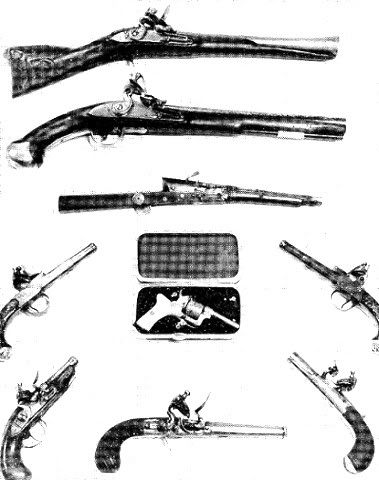
A small portion of the magnificent collection of pistols in the Boultbee Gallery. (Photo: Windsor Studios)
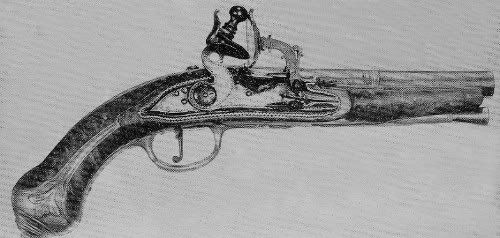
A particularly fine example of a flintlock pistol. (Photo: Windsor Studios)

Above and Below
Two views of the displays in the old Museum in the Silver Oaks building. Note the office on the right. (Photos: Windsor Studios)
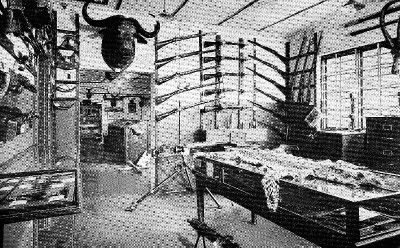
On 31st July, 1961, the Trustees approved a set of plans as submitted by the architects for the new building to an agreed expenditure of not more than £47 000, of which £5 000 was allocated for interior fittings, and building operations commenced in November, 1961. The foundation stone was laid by Sir Edgar Whitehead on 7th April. 1962.
On the 20th September, 1962, Sir Alfred Beit officially opened the Beit Gallery (the Beit Trust had contributed a large proportion of the finance for the Umtali Museum) and the keys of the building were handed over the following day. The move from the old building was completed on the 11th October, 1962.
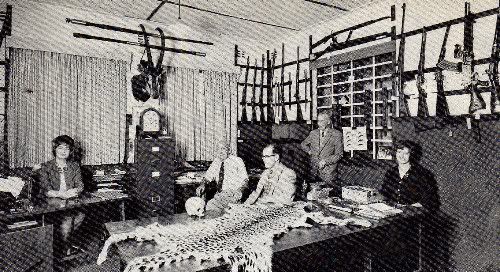
The staff at Silver Oaks in 1962. From left to right: Mrs.D. Norris (Secretary), Captain E. F. Boultbee (Curator), Mr. D. G. Broadley (Assistant Keeper of Zoology), Mr. C. J. McGranc (Caretaker) and Mrs. D. Liversedge (Display). (Photo: Windsor Studios)
At the time of the takeover by National Museums, Captain Boultbee had the assistance of a Secretary, Mrs. D. Norris, but otherwise relied heavily on help from qualified members of the Museum Society. In June, 1961, Mr. D. G. Broadley was appointed Assistant Keeper of Zoology. He had been Honorary Keeper of Herpetology at the National Museum, Bulawayo, since 1956. Mr. C. J. McGranc was employed as caretaker and Mrs. D. Liversedge was engaged on a temporary basis to assist both with secretarial and display work. At the beginning of 1963 Mr. R. Pletts, who had just left school, was employed as a technician on a temporary basis.
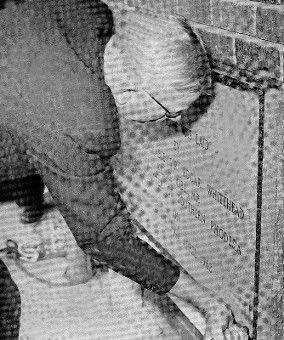
The foundation stone of the new Umtali Museum building was laid by the Prime Minister of Southern Rhodesia, Sir Edgar Whitehead, on 7th April. 1962. (Photo: Windsor Studios).
Initially, it was decided that the Director of Museums should act as Curator of the Umtali Museum, with overall control of administration and display, until funds were available to appoint a qualified Curator. Mr. D. G. Broadley was appointed Personal Assistant to the Curator, with responsibility for the day to day administration of the Museum, in addition to the detailed planning of displays in the Beit and Mezzanine Galleries. Captain E. F. Boultbee, Honorary Keeper of Arms and Antiquities, continued with the planning and arrangement of the displays in the Boultbee (Arms and Armour), Whitehead (Archaeology and Ethnology) and Transport Galleries. In October, 1963, Mrs. R. E. Blake joined the Museum staff as Secretary. Mr. T. N. Liversedge, who had just left school, joined the temporary display staff in 1964.
For the Umtali Municipal Jubilee Week celebrations, beginning on 8th June, 1964, the Museum (with the exception of the Eastern Districts Gallery) was opened to the public. A number of pertinent temporary displays was installed for the occasion. The Trustees of the National Museums, meeting at Umtali on 8th June, 1964, appointed Mr. D. G. Broadley, M.Sc., Curator of Umtali Museum.
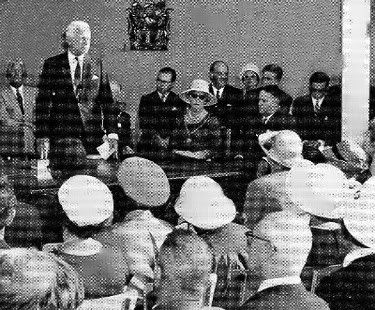
Sir Alfred Beit addressing the crowd that attended theofficial opening of the Museum on 13th September, 1964. (Photo: Windsor Studios)
Displays in all galleries of the new Umtali Museum were completed in time for the official opening by Sir Alfred Beit, Bart, on 13th September, 1964. The natural history displays in the Beit, Mezzanine and Eastern Districts Galleries were capably executed by a team consisting of Mr. R. E. Pletts (layout and taxidermy), Mrs. P. Kelly (backgrounds) and Mr. T. N. Liversedge, who collected most of the animals required for mounting and also cast many reptiles in latex for display. Perhaps the most outstanding cases were the Chirinda Forest case in the Eastern Districts Gallery and the "Introduction to the Insects" case in the Beit Gallery, the latter being entirely the work of Mr. Liversedge. Two striking displays were installed at the entrance of the Eastern Districts Gallery, these being a two metre high pictorial map of Manicaland by Mrs. Kelly and a series of colour enlargements of local wild flowers by Mr. D. C. H. Plowes. Mr. Plowes also personally arranged his excellent collection of birds' eggs (clutches) in a series of four cases on the Mezzanine Gallery; two adjoining cases housed the Rodney Wood collection of marine shells from the Seychelles.
The displays of live animals proved a big public attraction. The Herpetological Association of Rhodesia(Manicaland Branch) provided the funds for the construction of two reptile cases at the north end of the Mezzanine Gallery. Initially one was occupied by a pair of Gaboon Vipers [Bitis gabonica) from the Inyanga Tea Estates and the other by a Forest Cobra (Naja melanoleuca). Ten years later the same two Gaboon Vipers are still on display, accompanied by Vine Snakes, while for many years the second case has been devoted to some of the more colourful and spectacular local rock lizards.
At the other end of the Mezzanine Gallery two small aquaria were installed, one of them being occupied for six years by a Lung Fish (Protopterus annectens) from Beira. For two years a pair of live red squirrels (Paraxerus palliatus) was displayed on the verandah of the Transport Gallery.
The general layout of the Geology Display was prepared by the Curator in consultation with Professor G. Bond. Mr. J. Rushworth and Miss P. Letley subsequently set up the displays, while Dr. W. G. G. Cooper selected and prepared the specimens and Mr. E. J. 0. Mennell cut and polished many specimens for the display of precious stones.

Construction of the new Museum by Messrs. Umtali Construction Company. (Photo: Windsor Studios)
Captain E. F. Boultbee, assisted by Mr. C. J. McGrane, prepared the displays in the Boultbee and Whitehead Galleries and sorted out historical items worthy of display. The Curator undertook the overall planning of the cases in the Eastern Districts Gallery and five cases were allocated to the history of man in Manicaland, ending with a large case depicting a Pioneer group in a simulated pole and dagga hut.
The collection of animal drawn transport was transferred from the old Museum and the Transport Gallery was completed by the fabrication of a blacksmith's shop complete with tools. An important new transport exhibit was added when Rhodesia Railways installed, on indefinite loan, a Falcon narrow-gauge locomotive which had worked on the Beira-Umtali line in 1898.

The Staff at the new Museum in 1964.
Front Row (left to right): Mrs. P. Kelly (Display Artist). Mrs. R. E. Blake (Secretary), Capt. E. F. Boultbee (Hon. Keeper of Arms and Antiquities), Mr. D. G. Broadley (Curator and Keeper of Zoology) Mr. R. E. Pletts (Technical Officer). Mr. C. J. McGrane (Caretaker) and Mr. T. N. Liversedge (Display).
Back Row: Messrs. Augustine Mugetesa. Leonard Mutisi (Technical Assistants), Hudson Gondo (Messenger) Willard Bepete (Driver), Tonnie Kayangumbo and Albert Chipepera (Gallery Attendants). The Head Attendant (Mr. John Gondo) and the Hon. Keeper of Geology
(Dr. W. Cooper) were absent. (Photo: Windsor Studios)
In May, 1965, the death of Captain E. F. Boultbee,O.B.E., Honorary Keeper of Arms and Antiquities, at the age of 82, left the whole field of human sciences without a full-time officer. Mr. W. T. Perkins agreed to take over as Honorary Keeper of Arms, but for the time being the Curator had to deal with accessions and queries relating to history, archaeology and ethnology.
In 1965 many improvements were made to existing displays and three new ones were added in the Beit Gallery. Mr. Pletts completed a pair of large cases showing impala and bushbuck, with backgrounds painted by Mrs. P. Kelly. Mr. Liversedge designed and installed a display on modifications of "Birds' beaks and feet". Rhodesia Railways installed the little tank engine "Jack Tar" in an extension to the locomotive shed. The centre of the Beit Gallery was kept free of exhibits and was used for lectures and films organised by the Umtali Museum Society.
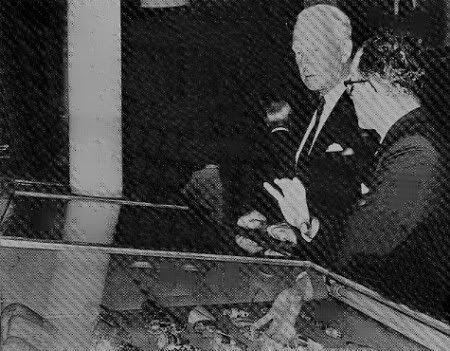
The then Curator Mr. D. G. Broadley. explaining one of the finer points in the Rodney Wood Shell Collection to Sir Alfred Beit (1964). (Photo: Windsor Studios)
In July, 1966, Rhodesia Railways installed a third exhibit on indefinite loan. This was the seventy year old De Beer's Directors' railway coach which was used as Rhodes' funeral car. The shed to accommodate this popular exhibit was financed by the Rhodesian State Lotteries. During 1966 Mrs. Kelly completed backgrounds for all the habitat groups in the Beit and Mezzanine Galleries.
During 1967 the displays in the Whitehead Gallery were completely renovated. The layouts for the new displays were prepared by the Curator and executed with the assistance of the Technical Officer and Mrs. P. Kelly (artwork), Mrs. E. Ross modelled a realistic nganga figure which dominated one corner of the gallery. A major contribution to the display was a fine series of enlarged photographs painstakingly prepared by Mr. and Mrs. J. P. Coates Palgrave. Black and white photographs show the principal "ruin sites" in Manicaland and a series of colour prints shows various aspects of kraal life photographed in Inyanga and Umtali Districts.
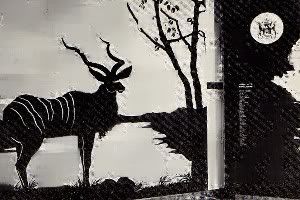
The entrance to the Eastern Districts Gallery. (Photo: Windsor Studios)
Two new zoological cases were completed. The Sabi-Lundi Case in the Eastern Districts Gallery has a ripple-glass water surface dividing the case horizontally and is dominated by a Fish Eagle above and Crocodile, Zambezi Shark and Sawfish below the surface. A case showing fibreglass casts of local freshwater fishes was installed at the south end of the Mezzanine Gallery.
On 6th April, 1966, the Museum was honoured by an unofficial visit from the Prime Minister, the Hon. Ian Smith and Mrs. Smith, who were the first visitors to pass through the Rhodes' coach following its complete renovation inside and out. Unfortunately this interesting exhibit was on display for only a year, for it was repossessed in May, 1967, by Rhodesia Railways for the Bulawayo 70th Anniversary celebrations.
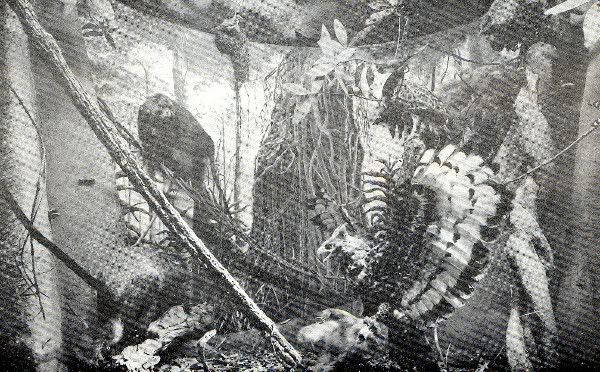
The Chirinda Forest case in the Eastern Districts Gallery. (Photo: Windsor Studios)
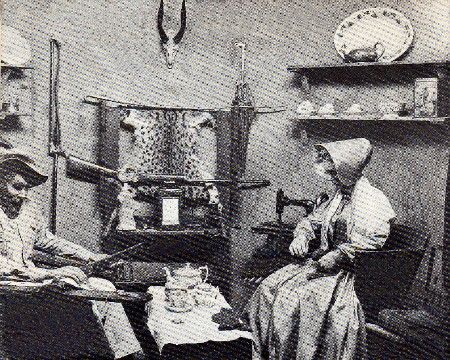
Above: The Pioneer Group in the Eastern Districts Gallery. — (Photo: Windsor Studios)
Below: The Transport Gallery and Blacksmith Shop (Photos: Windsor Studios)
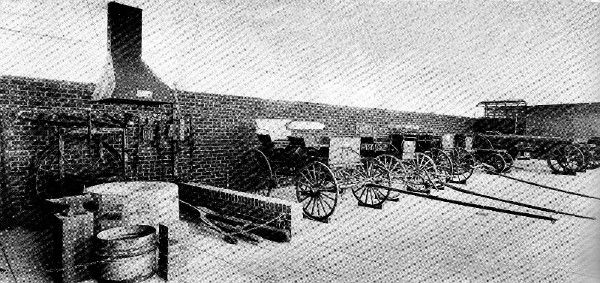
Mr. Alan Silberstein joined the Museum as Technical Officer at the beginning of 1968, but left to return to Israel at the end of the year. The post then remained vacant until June, 1969, when Mr. Ray Black arrived from Port Elizabeth Museum. The first display that he prepared covered the five species of marine turtle found along the Mozambique coast, plus the freshwater turtle Cycloderma, which enters Rhodesia at the Sabi- Lundi Confluence.
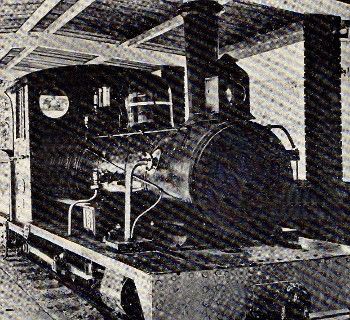
Above: The Falcon Narrow Gauge Locomotive. — (Photo: Rhodesia Department of Tourism)
Below: A case showing fibreglass casts of local freshwater fishes. Mezzanine Gallery. — (Photo: Windsor Studios
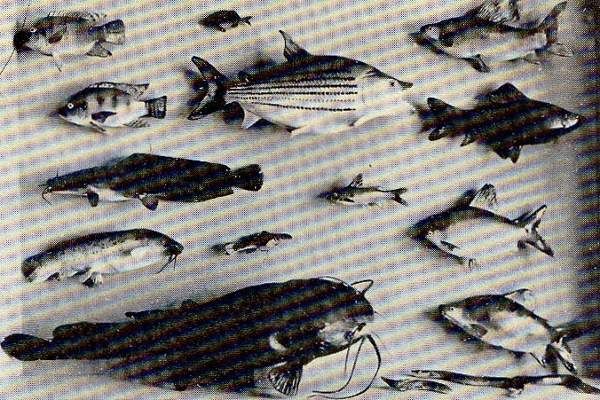
Mr. H. D. Jackson was appointed Keeper of Zoology on 19th January, 1970. He had previously served as Honorary Keeper of Ornithology at the Queen Victoria Museum. An appeal for funds to build an Umtali Museum Lecture Hall was launched. An observation beehive was installed in the invertebrate section of the Beit Gallery with the assistance of the Manicaland Beekeepers Association.
During 1971 the final stage in "blacking out" the Beit Gallery was completed and the Foyer was redesigned to provide a more attractive entrance, better facilities for the display of curios and publications on sale to the public and improved fittings for temporary displays. The outside display of old tractors was enhanced by the transfer of the 1 903 Ivel Tractor from the Mining Antiquaria collection at Bulawayo.
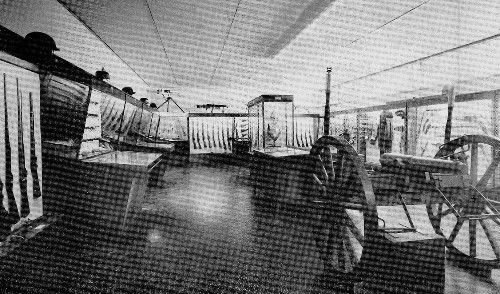
A view of the Boultbee Gallery. - (Photo: Windsor Studios)
In July, 1972, Mr. Miguel Bordini became the third professional officer on the Museum staff with his appointment as Keeper/Inspector of Antiquities. Miss G. Watson joined the staff as Secretary/Bookkeeper in May, 1972, but transferred to the Technical Staff in October, 1973. The workshop and study/storage areas were partitioned to provide discrete working and storage areas for four professional officers and the Technical Officer.
In October, 1972, Rhodesia Railways reclaimed the two remaining locomotive exhibits, "Jack Tar" and the Falcon narrow-gauge engine, for transfer to the new Railway Museum at Bulawayo. In return they donated "Winston Churchill", a 1929 Small Class locomotive and also agreed to move and install "Mary", a 1936 Peckett narrow-gauge tank locomotive donated by Rhodesia Chrome Mines Ltd. (Selukwe). A Marmon-Herrington Armoured Car of 1941 vintage was donatedby the B.S.A. Police.
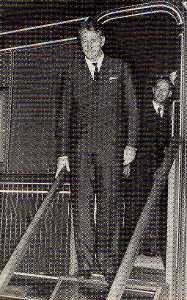
The Prime Minister, the Hon. Ian Douglas Smith, was the first visitor to pass through the Rhodes Coach following its complete renovation (Photo: Windsor Studios)
The first steps were taken towards the takeover of "Utopia", the old Fairbridge homestead, which was offered to National Museums and Monuments by Mr. H. T. F. Went, grandson of Rhys Fairbridge, who did the original survey of Umtali and was the father of Kingsley. The building will require considerable restoration before it can be opened to the public as an "old house museum".
At the end of July, 1973, Dr. D. G. Broadley relinquished the Curatorship in order to concentrate on herpetological research and Mr. H. D. Jackson was appointed Curator of Umtali Museum. Mr. R. A. R. Black was transferred to the Queen Victoria Museum. In September, 1973, Mrs. B. van Blomestein joined the staff as Display Artist (part-time).
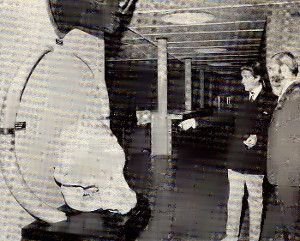
The Minister of Information. Immigration and Tourism, Mr. P. K. van der By I, pointing out the Martini-Henry bullet lodged in one of the elephant tusks on display in the Mezzanine Gallery. With him is the present Curator of the Museum, Mr. H. D. Jackson. — (Photo: Ministry of Information)
At the Annual General Meeting of the Umtali Museum Society held on 26th October, 1973, it was decided to dissolve the Society and hand over all assets to the Umtali Museum, which would set up a new Umtali Museum Society run by the Museum on rather different lines, including the issue of a monthly newsletter.

Above: One of the attractive habitat groups in the Mezzanine Gallery, showing lizards and some of their predators .(Photo: Windsor Studios)
Below: Chief Mutasa (right) admiring one of the animal displays in the Beit Gallery. (Photo: Windsor Studios)
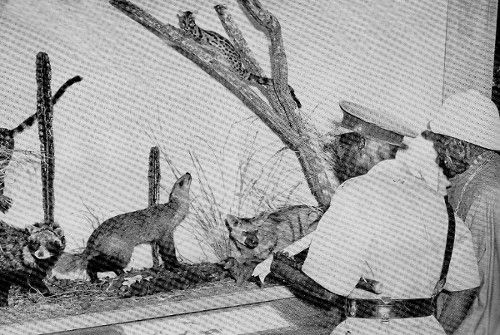
Developments planned for 1974 include the conversion of the Whitehead Gallery into a Lecture Hall. The displays covering the human sciences will then be transferred to the Beit Gallery.
DEPARTMENTAL ACTIVITY AT THE UMTALI MUSEUM
In the pages that follow, the heads of the various departments within the Umtali Museum allow a glimpse behind the scenes, revealing the activities which the casual visitor to the Museum is not aware of. All too often the public imagines that the Museum worker has nothing much to do other than dust the exhibits and polish the glass. However, as with the iceberg, the portion on show is but a small part of the whole; there is an extensive substructure supporting that which you see.
It is appropriate to draw special attention to the Department of Herpetology. Whereas the rest of the Museum is essentially limited to Manicaland in scope, the Department of Herpetology is responsible for the National collection of reptiles and amphibia, now numbering over 35 000 specimens. The Umtali Museum enjoys an excellent international reputation in the herpetological field and this is due entirely to the efforts of Dr. D. G. Broadley, the Senior Keeper of Herpetology and until recently Curator of the Museum. It is a pleasure to pay tribute to his achievements. As a result of the research he carried out at the Umtali Museum. Dr. Broadley was awarded a Ph.D. in Zoology.
I trust that future research work will lead to further academic awards not only in the Department of Herpetology but also in the other departments of the Museum.
H. D. Jackson
Curator. Umtali Museum
DEPARTMENT OF HERPETOLOGY
Donald G. Broadley
Keeper of Herpetology
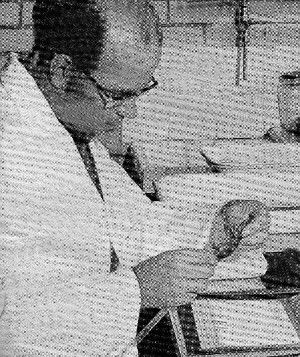
Dr. D. G. Broadley, Senior Keeper of Herpetology, measuring a lizard from the marked population in the Museum grounds. — (Photo: H. D. Jackson)
THE Department of Herpetology was not established until 1956, but the relevant catalogues show that the earliest collections of herpetological material date back to 1907, when Mr. F. P. Mennell was the first Curator of the Rhodesia (later National) Museum, Bulawayo. The basis consisted of the R. Edge collection of reptiles from Bulawayo.
The collection grew quite rapidly during the period 1911-1920 after the appointment of Mr. (later Dr.) George Arnold as Curator. Exchanges of material were arranged with the Durban, Transvaal and Albany Museums in order to establish a representative collection of South African species. In 1920 an exchange with the Museum of Comparative Zoology, Harvard, provided a useful collection of West African (mainly Cameroons) reptiles.
Dr. Arnold was a skilful technician and he prepared a comprehensive exhibit of painted plaster casts of reptiles and amphibians, many of which are still on display in the National Museum.
The period 1921-1947 saw little growth of the herpetological collections. Some additional South African material was obtained in exchanges with the University of Stellenbosch (1930) and Port Elizabeth Museum (1940), while a useful collection of reptiles from Dunbrody, C.P., was donated by Father K. Tasman, S.J. Accessions of herpetological material improved following the appointment of Mr. (later Dr.) R. H. N. Smithers as Director of Museums in 1947.
In 1949 a card catalogue of herpetological specimens was discontinued and a "miscellaneous" catalogue was
opened to cover reptiles, amphibians and fishes. There was a marked increase in the flow of specimens from Northern Rhodesia (now Zambia), especially from Mr. W. F. H. Ansell. In 1950 the National Collection received its first major accession of reptiles from East Africa, when Captain C. R. S. Pitman, C.B.E., D.S.O., M.C., donated a very comprehensive collection of snakes from Uganda and Tanganyika. Mr. L. D. E. F. Vesey-FitzGerald also contributed much material from the Northern Province of Northern Rhodesia and the Rukwa Valley in Tanganyika.
A few snakes had been preserved at the Queen Victoria Museum over the years and these were catalogued by D. G. Broadley in 1955. During the year he added 41 specimens to the existing collection of 31 snakes. He moved to Matabeleland towards the end of the year and was appointed Honorary Keeper of Herpetology at the National Museum at the beginning of 1956. At this time the National Herpetological Collection consisted of less than 1 000 specimens.
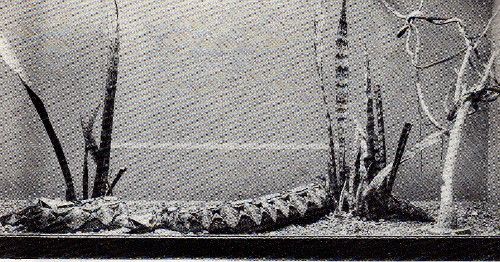
The display of live snakes at the Umtali Museum. The main attraction is the pair of Gaboon Vipers; the smaller male is on the left, the enormous female in the centre. In the tree are some Vine Snakes (Thelotornis capensis)
(Photo: Windsor Studios)
The formation of the Herpetological Association of Rhodesia in 1957 stimulated interest and accessions for the year rose to nearly 600. "Snake Parks" were put on at the Bulawayo and Umtali Agricultural Shows and public lectures were given by the Hon. Keeper in Bulawayo and Selukwe.
The first major publication to emerge from the Department was The Herpetology of Southern Rhodesia. Part 1 — Snakes, which was published in 1959 in the Bulletin of the Museum of Comparative Zoology, Harvard. Taxonomic papers on the reptiles of Rhodesia and Nyasaland were published at regular intervals from 1958 onwards and a series on Rhodesian snakes appeared in African Wild Life.
In November, 1959, the Hon. Keeper moved to Salisbury to take over as Director of Salisbury Snake Park. He resigned from this post in October, 1960, and subsequently carried out field work in Mtoko and Wankie Districts.
In June, 1961, the Hon. Keeper joined the National Museums' service as Assistant Keeper of Zoology at Umtali Museum. The National Herpetological Collections (now comprising 6 000 specimens) were transferred from the National Museum to Umtali and were initially housed in a room in the Civic Centre because of lack of space in the old Museum building. Accessions for the year passed 2 000 for the first time, while this figure rose to just under 3 000 for 1962, when the collections were moved into the new Museum building.
In 1963 the Keeper completed his M.Sc. thesis for the University of Natal, a monographic study of the cordylid lizard genus Platysaurus. Field work concentrated on central Mozambique and the large collections of amphibians obtained were made available to Dr. J. C. Poynton for inclusion in his definitive Amphibia of Southern Africa (1964).
Pressure of display work inhibited both field work and research until the new Museum was opened to the public in September, 1964.
The Keeper decided to concentrate research on the herpetofauna of south-eastern Africa, including Rhodesia, Botswana, Zambia, Malawi and Mozambique, although it was often necccssary to make generic revisions pan-African in scope. Numerous field trips were made in order to build up the collections, which served as a basis for his Ph.D. thesis The Herpetology of South-East Africa in 1966.

The formidable fangs of a Gaboon Viper (Bids gabonica). (Photo: R. Shannin)
A large proportion of field work was allocated to Mozambique, and in the period 1962-1971 field expeditions have visited a wide variety of places more or less covering the country, and investigating also adjacent areas such as Zululand and the whole of Malawi. Some of the most productive areas have been places where road construction was underway, and also the trench excavated for the ill fated Beira-Umtali oil pipeline.
Other field trips have taken in Botswana — especially the south-west Kalahari — and the south-east of Rhodesia in the Gona re Zhou Game Reserve, so that field work has, by design, covered a wide range of habitat types from forest to desert, in a wide range of ecological conditions, from coastal to montane, and the rewards in terms of collections made have been well worth the efforts invested.
The National Herpetological Collections now total over 35 000 specimens, mostly from Rhodesia, Botswana, Zambia, Malawi and Mozambique. Reference collections covering the rest of Africa are gradually being built up by exchanges with other Museums in South Africa, the United States and Europe.
Until the Botswana Mammal Survey got into full swing, most of the material sent to the Department of Herpetology for identification consisted of entire specimens. Subsequently a steady flow of fragmentary reptiles and amphibians from carnivore stomachs were submitted for identification, and this has contributed many useful distribution records, quite apart from the value of the predation records. It is hoped that in future more herpetological material from the crops of birds will be sent in by ornithologists.
Another development is the receipt of reptile and amphibian bones from archaeological deposits for identification. This began with a collection of tortoise bones from Makapansgat provided by the Bernard Price Institute, which was written up in 1962. More recently, collections from stone age sites in Matabeleland have contained tortoise fragments, lizard mandibles, snake vertebrae and bullfrog skull fragments. In order to facilitate identification of this type of material, comprehensive collections of osteological specimens will have to be built up. A good representative collection of snake skulls was prepared by Mr. A. Silberstein in 1968 and this is now being supplemented by collections of snake vertebrae and lizard skeletons.
Although much work remains to be done on the taxonomy of African reptiles, the situation in south eastern Africa has been greatly clarified after examination by the Keeper of most of the relevant type material in the European Museums during 1968. Work is now proceeding with the preparation of a book The Reptiles of South-East Africa, which will summarise all available data on the taxonomy, zoogeography and ecology of the group.
The provision of "semi-popular" texts, aimed especially at school-children, has not been overlooked.
A new book. Snakes of Rhodesia, is being prepared by the Keeper with Dr. E. V. Cock, of Salisbury, as co-author. The remaining reptile groups have been dealt with in an inexpensive book available in Rhodesia.
In 1972 a start was made on setting up a marking/recapture programme for various local lizard populations, using toe clipping for permanent identification and paint patches for short-term recognition. The first lizards to be marked were Tree Agamas (Agama cyanogaster) in the Museum grounds. Subsequently this programme was extended to the Striped Skinks {Mabuya striata), Plated Lizards (Gerrhosaurus flavigularis) and Spiny Agamas (Agama hispida).
A field study of the dwarf chameleon Rhampholeon marshalli in the Bunga Forest National Park (Vumba Mountain) was launched in April, 1972, in collaboration with the Department of National Parks and Wild Life Management. A transect was established close to the road through the forest, with reference pegs at 10m intervals. The sleeping chameleons are located at night with headlamps, measured, marked by clipping claws in a numerical sequence, their exact position recorded and then released at the spot where found,
A new study area on the edge of Zimunya Township was selected for marking/recapture studies of two short-lived sand lizards (Ichnotropis squamulosa and I. capensis) and the Spiny Agama (Agama hispida).
Specimens of tortoises, terrapins and lizards (mainly the large plated lizards Gerrhosaurus vafidus and G. major) are being marked at a study area on Ranelia Farm, 50km south of Umtali.
A population of the Rhodesian Girdle-tailed Lizard (Cordylus rhodesianus) is under observation on a rocky ridge near the TV mast on Cecil Kop, Umtali.
Miss G. Watson joined the technical staff in October, 1973, and has made a start on the analysis of reproductive tracts and stomach contents of the lizards in the study collections. After completing work on the Plated Lizards (Genus Gerrhosaurus) she has made a start on the skinks, an interesting group because it contains both oviparous (egg laying) and viviparous (live birth) species.
In 1965, the Herpetological Association of Rhodesia was absorbed into the Herpetological Association of Africa, with its headquarters in the Department of Herpetology at Umtali Museum. A mimeographed Journal is published twice a year to keep members abreast of the latest developments in African herpetology.
The future research programme of the Department will probably show a gradual swing away from taxonomic and zoogeographical studies and a corresponding increase in projects concerned with ecology and behaviour. This is a healthy development, but worthwhile ecological studies must be based on a sound taxonomic foundation.
M. A. Bordini
Keeper of Antiquities
THIS Department has only recently officially been formed in the Umtali Museum and thus the three National Museums of Rhodesia are now represented in the field of Human Sciences. Staff comprises the Keeper and an African Assistant Inspector whose duties include the inspection and maintenance of monuments. The study is extremely vast, involving as it does many separate disciplines. One of the policies is to carry out research in Ethnoarchaeology and Ethnohistory and in this way attempt to obtain a clear picture of the prehistory of the Eastern Districts.
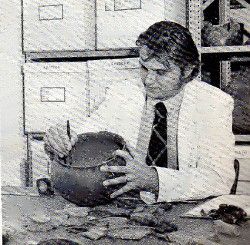
Mr. M. A. Bordini. Keeper of Antiquities and Inspectorof Monuments, at work in the Human Sciences Laboratory. (Photo: Windsor Studios)
Much material had been accumulated prior to the appointment of a Keeper of Antiquities and it was therefore necessary to spend a great deal of time in classification and recording of the items. In the field of Archaeology, material from the Ziwa Complex has now been recorded and this forms a very important basis for research.
Services provided for the public by this Department include identification of archaeological, ethnological and historical material, with special emphasis on the Eastern Districts. Material received is classified and recorded on a card system for the purpose of comparative study and research. All inquiries are always appreciated, no matter how trivial, since what may at first sight appear to be of minor importance may in fact provide valuable research material for the Department.
The scope of the Department is widening rapidly as the area is rich in archaeological sites and material is continually being received. Furthermore, because of our proximity to Mocambique, the Portuguese influence during the Sixteenth and Seventeenth Centuries is of great importance in the chronological order of pre-historic events in Rhodesia. The area involved is extremely wide; the scope is vast.
All material received is dealt with in the Department Laboratory. This is a new addition, having been completed in 1972. Over five hundred items have been classified and recorded and there is a comprehensive range of material from several parts of the world, including Tibet and New Guinea. Accessions are increasing rapidly.
A departmental library has recently been formed and the intention is eventually to have a wide range of books and journals dealing with all branches of the Human Sciences. This library will fill an important gap in the field of research.
There are two galleries in the Museum covering the Human Sciences. The Whitehead Gallery deals exclusively with archaeology and ethnology. The archaeological displays cover the emergence of man; Early Stone Age; Middle Stone Age and Late Stone Age. Many implements of those periods are exhibited, together with reproductions of rock paintings in the Eastern Districts. The Iron Age is covered and a variety of copper, iron and bronze bracelets of the period shown. The display also includes examples of pottery and agricultural implements.
Not so far from the centre of Umtali is the Murahwa's Hill Nature Reserve where many excavations have been carried out in the past. Items recovered from these excavations are displayed. The Ziwa people were the first farmers in the area and many items of pottery relevant to their industry are shown, together with a display of a Ziwa burial. In addition there is a model of an iron smelting furnace (ca 18th century) from Ziwa Farm in the Inyanga district. The Inyanga area, comprising Nyangwe Fort, Van Niekerk's Ruins and Nyahokwe Village is depicted and a good collection of pottery and implements is included in the display.
A short distance from Umtali is a site known as "The Altar". Early this century a British expedition carried out excavations there and many interesting soapstone figurines were discovered. Several reproductions of the original figurines are displayed. One of the major future research projects of this Department is to carry out fieldwork at "The Altar" site.
Examples may be seen of the rare geometric rock engravings found in Manicaland which may have been the work of Iron Age people.
In the Ethnological displays, there are many examples of modern utilitarian pottery and basketware, together with a collection of snuff boxes, headrests and ceremonial axes. A collection of knives from the Eastern Districts shows intricate carving and copperwork. These traditional forms of decoration are still to be found. A figure of an Nganga ("Witchdoctor") with his typical regalia and equipment is shown.
The Eastern Districts Gallery deals with the early history of Manicaland. Of particular interest historically is the panel showing the existence of Portuguese mission stations in the area during the Sixteenth and Seventeenth Centuries.
Approximately twenty miles from Rusape the Diana's Vow rock painting, which is a national monument, may be seen. A copy of this painting forms the background panel in the first case of this Gallery. The rock painting depicts one of the most intricate scenes found in rock art in southern Africa.
Details of the pioneer period are given and include many photographs of personalities and their personal possessions. The history of the various centres is outlined in the text and photographs, incorporating Umtali, Inyanga, Mt. Selinda and the Gazaland area.

Archaeological field work in progress: Mr. Bordini andhis Assistant, Mr. I. Mandipaza. opening up a grave near Bonda Mission. (Photo: R. A R. Black)
The Keeper of Antiquities' duties include inspection of the national monuments in the Eastern Districts and regular visits are paid to these sites to ensure that they are well maintained. The small Nyahokwe field museum at Inyanga contains a small but excellent display of relics. In addition reconstruction of a pit village at Inyanga has been undertaken and these two features have proved to be of great interest to the public. The large Inyanga district is particularly rich in relics. It is frequently visited by tourists and this results in many reports of hitherto undiscovered archaeological sites. Due to the nature of the climate in the eastern border mountains the forts and rock paintings require constant attention to prevent deterioration.

A display in the Whitehead Gallery, showing an excavated Ziwa burial. Photo: Windsor Studios)
The upkeep of the national monuments, together with continual research in the field of Human Sciences, is extremely important as this forms a vital part of Rhodesia's national heritage.
DEPARTMENT OF ZOOLOGY
H. D. Jackson
Keeper of Zoology
THE Department of Zoology at the Umtali Museum is concerned mainly with birds, especially with the nightjar family. The planned programme of research is entirely ornithological but mammals, reptiles and amphibia are collected as a matter of routine while in the field. The Department is responsible for processing all zoological material received from the public with the exception of reptiles and amphibia, which are handled by the Department of Herpetology. The nightjar collection is the only national collection held but excellent unit collections of birds, birds' eggs, mammals, fishes, butterflies, moths and beetles are maintained for the benefit of the public.
The Department of Zoology was established in 1961, the first Keeper being Mr. D. G. Broadley, the well- known herpetologist. Early in 1970 a separate Department of Herpetology was set up with Dr. Broadley as Senior Keeper of Herpetology, responsible for the national collection of reptiles and amphibia. Mr. H. D. Jackson succeeded Dr. Broadley as Keeper of Zoology, with a consequent swing in bias towards ornithology. Mr. Jackson is assisted by two Technical Assistants, Mr. Phineas Muchineripi and Mr. Morgan Nyakabau, and frequent use is made of young high school enthusiasts during school holidays.
Nightjar Research
The major research project being undertaken by the Department is a long term study of the nightjars of the world, and their allies the frogmouths, owlet-frogmouths, potoos, and oilbird i.e. the one hundred or so species comprising the order Caprimulgiformes. This order, which is cosmopolitan in its distribution, presents some challenging evolutionary problems, particularly in relation to the Gondwanaland concept. The study, which will probably not be completed before the turn of the century, is aimed at resolving some of these problems and it is hoped ultimately to produce a definitive monograph on the order.
Taxonomic studies on birds usually rely heavily on morphological similarities and differences to determine the relationships between the various forms. This approach has severe limitations when dealing with a homogeneous group such as the nightjars, whose cryptic plumage patterns serve to camouflage rather than to identify. Consequently our study concentrates on the living bird, both in the field and in captivity. Particular attention is being paid to breeding biology, behaviour and population dynamics.
Each year we spend the period August to December in a study area of some 100 hectares, 50km from Umtali, within which five of the six nightjar species that occur in Rhodesia are found. Four of them breed there, the fifth being a Palaearctic migrant that does not breed in Africa at all. Most of the individuals in the study area have been trapped and ringed with numbered rings over the past few breeding seasons and many have subsequently been recaptured in the same nesting territories with the same partners. It is hoped that by following the fortunes of this marked population for several seasons we shall gain an understanding of the complex life histories of our species for comparison with the species occurring elsewhere in the world.
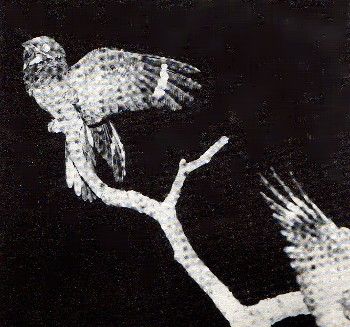
A male Fierynecked Nightjar (Caprimulgus pectoralis) displayingto a female arriving at his song perch.
(Photo: H. D. Jackson)
Our efforts at present are concentrated particularly on the Fierynecked Nightjar (Caprimulgus pectoralis fervidus). since it is extremely common in the study area. To assist us in locating individual birds and monitoring their movements we plan to fit them with mini radio transmitters which can be tracked with portable receivers.
Future plans include field studies in Australia and South America, where there are many species that appear to be very closely related to ours.
The Avifaunal Survey of the Umtali Municipal Area
It is a remarkable fact that ornithologists have neglected this fair city. Many have called here, but only in passing: they have been too anxious to reach the glamour spots on the Eastern border — Chirinda Forest, Haroni-Lusitu Confluence, Chimanimani Mountains, Vumba, Pungwe Gorge, Inyanga. These names conjure up a host of rarities in the bird world, yet we find that many of these varieties occur right here in Umtali, indeed are quite common; Grey Waxbill, Broadbill, Gorgeous Bush Shrike, Green Twinspot, Narina Trogon, Grassbird, Malachite Sunbird, to name just a few.
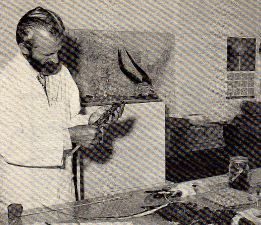
Mr. H. D. Jackson, Keeper of Zoology, examining nightjar specimens in the Zoology Laboratory.
(Photo H. D. Jackson)
To rectify this situation the Zoology Department is conducting a survey of the birds occurring within the Municipal Area. This area, which is some 158 square kilometres in extent, is particularly interesting from the ecological point of view, since altitude varies from 915m to 1 740m and there is a diversity of habitat ranging from moist montane evergreen forest in the east to dry Acacia thornveld in the west. Our survey therefore is aimed not only at establishing which species occur in the Municipal area but also what the preferred habitat of each is. This is being done by drawing a random sample of 500 individuals from a restricted area covering two or more discrete habitats and then statistically comparing the results for the different habitats. Each year a new area is selected and a camp established there from January to April for collecting the sample. In time the entire Municipal area will have been sampled adequately in this way and the data may then be synthesised to give a comprehensive picture of bird distribution within the city limits.
Future plans include the production of a popular guide to the birds of Umtali, based on the results of the survey. We shall then probably turn our attention to the Vumba, which has yet to be thoroughly investigated ornithologically.
Education
In addition to the scientific papers published as a result of the research activities mentioned above, the Department of Zoology plays an active part in the educational field. The Keeper is frequently invited to address scientific, cultural and welfare organisations and periodically participates in radio and television broadcasts. We also run a series of formal lecture and field courses in ornithology for both adults and children.
It is hoped in time to extend the coverage in this field as additional staff becomes available.
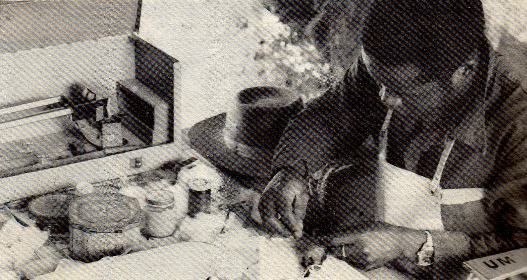
Ornithological field work in progress; Mr. P. Muchineripi, Senior Technical Assistant, preparing a bird specimen. (Photo: H. D. Jackson)
The Unit Collections
A most useful educational aid available to the public is the series of unit collections of animals being built up and maintained in the Zoology Department. These collections are designed to provide a quick identification service and consist in the main of three specimens (male, female and juvenile) of each species occurring in Manicaland. The vertebrate collections are fairly comprehensive, particularly the bird collection. Special mention should be made here of the Darrel Plowes egg collection, an excellent reference collection of birds' eggs.
The invertebrates are, of course, more difficult to provide for and many groups are not represented at all. The Sheppard collection of butterflies and moths is both beautiful and valuable; it is frequently consulted by budding entomologist and experienced lepidopterist alike. The unit collection of beetles is progressing well and it is hoped soon to deal with the dragonflies. It will, however, be a long time before adequate coverage of the vast host of invertebrates will be achieved.
The Public Displays
Most of the visitors to a museum are unaware of the fact that there are reference collections available or indeed that research is being carried on behind the scenes by both professionals and amateurs. It is therefore important to have a cross section of the area's fauna on display in the public galleries. In this respect the Umtali Museum is particularly well endowed, with numerous dioramas showing the animals of the Eastern Districts in natural settings. The Impala case is perhaps the most realistic of them all. Beautiful as these dioramas are, we plan to extend and improve the zoological coverage by providing more educational displays in the future.
The public enjoys live exhibits. It is therefore not surprising that the working hive of honey bees is one of the most popular exhibits in the Museum. The intricate behaviour of these insects, including the famous dance language, can be watched in perfect safety through a glass screen. The bees, which forage along the river outside the museum, gain access to the hive through a small opening in the outside wall, and if they have just arrived laden from a good source of food they perform an elaborate dance which is closely watched and followed by their fellow workers. In this way the location of the food source is communicated to those who have not yet been there.
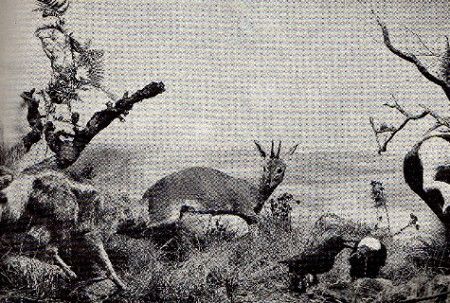
One of the many attractive dioramas showing animals in their natural surroundings; the Inyanga case in the Eastern Districts Gallery. — (Photo: Windsor Studios)
The ways of the wild are many and varied. It is our privilege to study them and our pleasure to share the results with you. We hope you enjoy the offering.
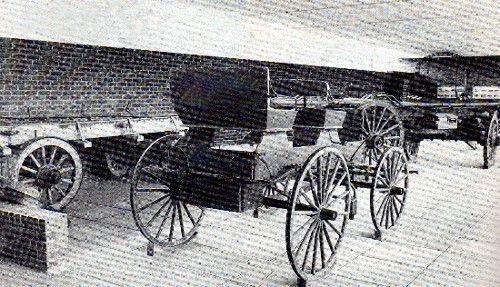
Above: Transport Gallery. — (Photo: Ministry of Information)
Below: The Whitehead Gallery. — (Photo: Ministry of Information)
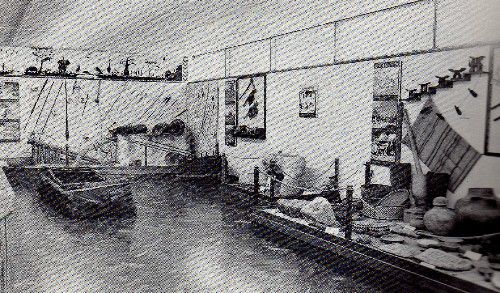

Above: The Mezzanine Gallery — (Photo: Ministry of Information)
Below:The Beit Gallery. — (Photo: Ministry of Information)
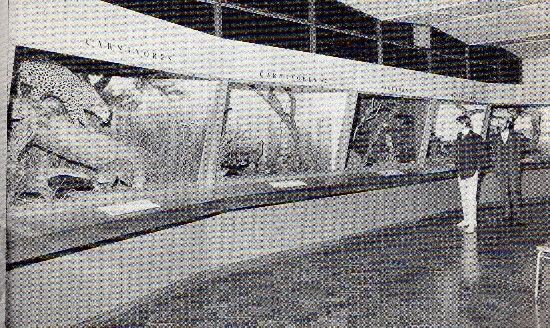

Above
Umtali Museum Staff— 1974. Front Row (L. to R.): Mrs. B. A. van Blomestein (Display Artist), Miss G. M. Watson
(Technical Officer). Mr. W. T. Perkins (Honorary Keeper of Arms). Dr. D. G. Broadley (Assistant Curator and Senior
Keeper of Herpetology), Mr. H. D. Jackson (Curator and Keeper of Zoology), Mr. M. A. Bordini (Keeper of Antiquities
and Inspector of Monuments). Dr. W. G. G. Cooper (Honorary Keeper of Geology). Mrs. F. L. Heppell (Secretary) and
Mrs. M. Brown (Bookkeeper/Librarian).
Back Row (L. to R.): Mr. E. Mudada (Gallery Attendant). Mr. M. Kapanga (Gallery Attendant). Mr. H. Gondo
(Messenger). Mr. J. Gondo (Senior Gallery Attendant). Mr. T. Kayangumbo (Head Attendant). Mr. A. Chipepera
(Senior Technical Assistant), Mr. /. Mandipaza (Assistant Inspector of Monuments) Mr. S. Kutsiro (Gallery Attendant).
Mr. S. Ziya (Technical Assistant) and Mr. N. Mangezi (Technical Assistant).
Absent: Mr. J. Mudimu (Gallery Attendant) and Mr. P. Muchineripi (Senior Technical Assistant). — (Photo: Windsor Studios)
Below: The Reception and Sales Desk in the Foyer of the Umtali Museum, with the Head Attendant. Mr. T. Kayangumbo. (Photo: Windsor Studios)
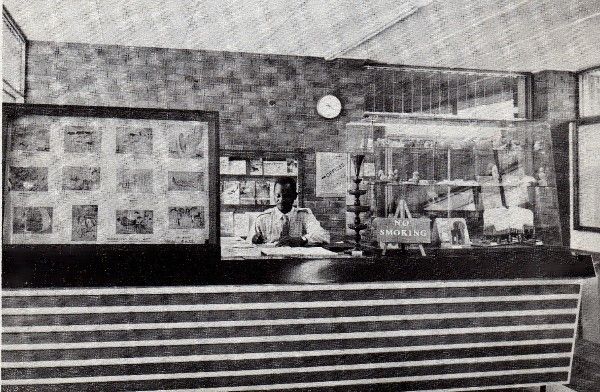
DEPARTMENT OF GEOLOGY
W. G. G. Cooper
Honorary Keeper of Geology
THE Collection of specimens commenced some years ago when the museum was housed in a small temporary building and most workers were members of the Umtali Museum Society. The present Honorary Keeper of Geology is a retired Officer of the British Colonial Geological Surveys, and his appointment followed a request by the local 'Small-Workers Association' to appoint a Geologist or Mineralogist to assist in the identification of rocks and minerals.
The Museum's Geological Department consists of a row of cases along one side of the Beit Gallery and a small laboratory in the basement. The latter is equipped with sink, a rock cutting and polishing machine, chemical balance, microscope, fluorescent lamp, Geiger counter and 3 selection of common reagents. There are four cases for minerals and rocks not exhibited in the Beit Gallery.
In the Beit Gallery there are four large table cases and six wall cases, the former for rock and mineral specimens and the latter for maps, photographs and diagrams.
At the end of the gallery there is a geological relief map which shows clearly the topography of the country and the geological formations on which it is based. The 'Great Dyke' which is well known for its basic rocks and important economic minerals, is clearly shown as the "backbone" of the country.
The exhibits are designed to interest and educate thepublic in local mineral development. The examination and identification of mineral specimens is free. From time to time competitions are arranged for young people, and school classes visit the museum with their masters.
The Museum Society occasionally arranges excursions to places of interest geologically, and these are invariably well attended.
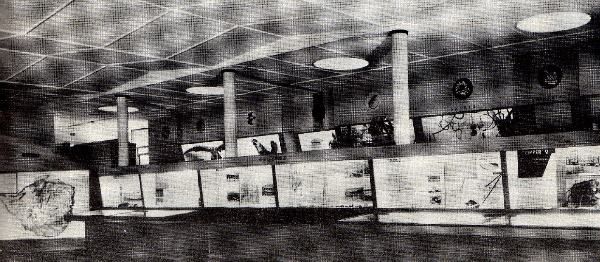
A general view of the Geology Display in the Beit Gallery. — (Photo: Windsor Studios)

Above: Introduction to Geology. — (Photo: Windsor Studios)
Below: Economic Geology. - (Photo: Windsor Studios)
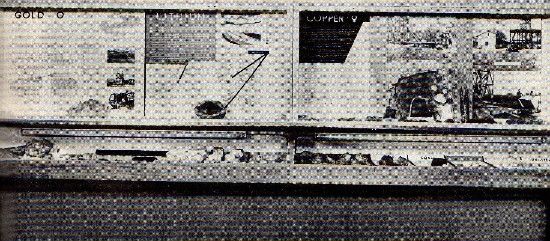
The following is a brief description of the main geological exhibits in the Beit Gallery:—
Wall Case 1:
This gives a brief introduction to Geology mainly in pictorial form. A small exhibit of minerals is classified chemically, with notes on chemical composition and economic uses.
Diagrams and profiles show the effects of various rock types upon land forms and weathering. Folding is illustrated in specimens and diagrams, and a few fossils are shown.
Table Case 1:
This contains typical rocks from the main stratigraphical systems and igneous rocks.
Wall Case 2 and Table Case 2:— 'Ring Structures'
These peculiar ring structures were little known until after the 1939 war when many Air Force planes were diverted to aerial mapping by photography.
Ring structures are of igneous origin and are quite commonly associated with the African rift valleys.
A geological map of Marangudzi in Rhodesia clearly shows the ring formation.
Wall Case 3:
This contains maps and photographs of two highland areas with relatively high rainfall.
Wall Case 4:
This is devoted to the Sabl Valley, an example of a small rift valley, wide and flat bottomed, of low altitude and consistently hot. It is irrigated by water from dams across rivers in the hilly Fort Victoria district. One of the most beautiful of the local dams is that of Lake Kyle, on the Mtilikwe River.
Maps, photographs and samples of the different soil types are shown.
Table Case 5:
The chief ores and minerals of the following are shown:-
Gold, asbestos, lead, iron ores, corundum, vermiculite, magnesite. lithium minerals, beryl. pollucite (caesium ore), tin and tantalum.
In the Centre of the case there is an interesting exhibit of polished gem and semi-precious stones lent by E. J. Mennell, Son of the late well-known geologist F. P. Mennell. the first Curator and mineralogist of the National Museum, Bulawayo, appointed by Cecil Rhodes at the request of local mining men.
Wall Cast 5:
Ores of gold and lithium with photographs of the Rezende Mine.
Table Case 6:
The chief ores of copper, coal, bauxite (aluminium ore), limestone and the ores of tungsten (wolfram and scheelite).
Wall Case 6:
Maps and photographs of the Umkondo Copper Mine.
The conversion of the Whitehead Gallery into a Lecture Hall will allow for the establishment of a small secure gallery next to the entrance foyer. It is planned to develop this as a Gemstone Gallery that will considerably enhance the existing geological displays.
DEPARTMENT OF ARMS
W. T. Perkins
Honorary Keeper of Arms
TOWARDS the end of 1957 the Umtali Municipality kindly made available, to the then Museum Society the wood and iron kitchen and dining-room block of a disused Hostel called Silver Oaks, situated a few hundred yards from where the Museum now stands. The Boultbee Gallery collection started there; in fact it would be true to say that the initial interest in firearms was largely responsible for the establishment of a museum in Umtali.
As is nearly always the case with small beginnings, it was the generosity of a few public-spirited people and organisations, and their help, which set the foundation of what can be seen today. To draw up a list of names would make lengthy reading but a few would not be out of place here. Pride of place must go to that truly wonderful person the late Colonel J. A. Methuen, who had an excellent collection of military equipment and accoutrements, some of which he donated to our collection, including the very fine 71b. field gun. The B.S.A. Police have always been of great help and quite recently gave us our Marmon-Herrington Armoured Car. From time to time the Magistrate's Court has presented us with most interesting objects of combat confiscated by the courts, and the Army and Air force have also contributed valuable items. It goes without saying that the Queen Victoria and National Museums have helped to a great extent in assembling what is, now, a very comprehensive collection.
Three major collections form the bulk of the firearms display. Firstly, the Methuen collection already mentioned, consisting largely of the heavier pieces. Then, the nucleus of the small arms collection brought out from England and donated by Captain Ned Boultbee, who was Honorary Keeper of Arms until the time of his death in 1965. Finally, the small and medium arms added by the present Honorary Keeper of Arms, Mr. W. T. Perkins, successor to Captain Boultbee.
Any collection is a living thing and it is important that the public be made aware of the fact that a tremendous number of valuable collectors' items are unwittingly thrown away each year as useless rubbish. Wherever possible, these items should be offered to the Curator or the Honorary Keeper of Arms for disposal.
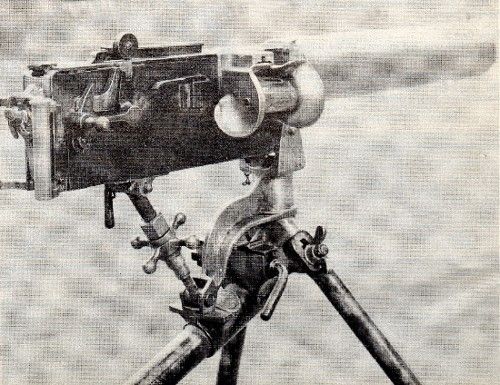
A Maxim-Nordenfelt Machine Gun on display in the Boultbee Gallery (Photo: Windsor Studios)
THE CHASE HERBARIUM AND UMTALI MUSEUM ARBORETUM
D. G. Broadley
Assistant Curator
THE Chase Herbarium was started by Mr. J. Mullins about 1960 and was initially housed in the Department of Conservation and Extension. It soon outgrew the space available and in 1964 it was transferred to the Umtali Museum and was looked after on an honorary basis by Mr. R. F. Finch, a retired Forestry Commission officer. Mr. Finch left Rhodesia in 1968, by which time the herbarium had again filled the space allocated to it. It was moved to the Museum study-storage area, rehoused in new storage cabinets donated by Mr. L. Attwood, and placed on a care-and-maintenance basis, as
no botanist was available to work on it.
The Chase Herbarium now contains 1 137 specimens, representing 904 species and 497 genera. Mr. N. C. Chase himself provided 459 specimens, most of the others being collected by Mr. D. C. H. Plowes (duplicates of Manicaland material collected since 1956) and Mr. J. Mullins (duplicates of material collected 1960-64).
The Umtali Museum Arboretum at present consists of a strip of land bisected by the Nyapfumbi Stream, extending from the Victory Avenue road bridge to a line projected from the Museum back fence with the Roads Department fence forming the south-eastern boundary. Until the early 1960's the stream flowed all the year round, but a series of drought years and the clearance of reedbeds upstream have reduced it to the status of a stormwater drain. This piece of ground is zoned as a public open space, but in December 1966 the Umtali Municipal Council agreed to its development by the Museum as an arboretum.
Since then most of the exotic trees have been cut out and seedlings of indigenous species planted, many of the earlier ones being supplied by Mr. Norman Chase from his nursery on Murahwa's Hill. Others were provided by Mr. R. W. Barnes while he was at the John Meikle Research Station (Stapleford), Mr. T. Muller of the National Botanic Garden and Mr. and Mrs. J. P. Coates Palgrave. Mr. J. H. Lambert also contributed trees from the Umtali Municipal Nursery, including some well established Red Mahogany saplings. The arboretum lies at an altitude of 1 100 metres, which makes it feasible to try both montane and lowland forest species. The South bank of the stream consists largely of decomposed granite with shallow topsoil mixed with debris from the old Victory Avenue Bridge and old rubbish dumps, while on the north bank the decomposed granite is covered by about four metres of black cotton soil.
It is planned, in time, to label representatives of all tree species in the arboretum, and many are already labelled with the scientific name.
Future plantings in the arboretum will consist largely of evergreen forest species along the stream and savanna species in the open ground between the stream and the Museum. It was planned to establish footpaths through the arboretum and bridge the stream, but the flash floods that follow heavy rain have already removed one log bridge.
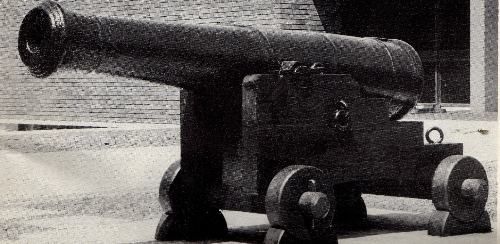
The impressive three inch calibre naval cannon, made in 1794. which stands at the entrance to the Umtali Museum.
(Photo: Windsor Studios)
DISPLAY DEPARTMENT
B. A. van Blomestein
Display Artist
AS the shop window of a Museum, the Display Department must attract a large cross section of the public, from little children and semi-literates to university students. Its function is to stimulate interest in natural history and human sciences, at the same time providing a means of education. The exhibits in the Umtali Museum show the varied flora and fauna of Rhodesia's beautiful eastern border province, Manicaland, with sections covering the history of its peoples.
Conditions in the old "Silver Oaks" building, used as the Umtali Museum from 1957-1962, were far from satisfactory. There were no adequate working facilities and the area for display was limited. Due to lack of storage space, all collections owned by the Museum were on display and every conceivable nook and cranny was utilised. There was little planned arrangement of items: a crocodile skin reposed on top of the Sheppard Butterfly collection; the historical and ethnological material, which was a varied selection from many different parts of the world, was displayed wherever space was available; the firearms were housed in the office with just enough room left for the office desk; the library (a cupboard) had a Japanese helmet hanging on its door; the sable antelope's label was firmly tied to one of its horns with a wasp nest exhibit underneath its belly; animal skulls were neatly arranged on an old trailer and a human skull was clamped in the jaws of a lion's head. It must be said that the old Umtali Museum had plenty of character.
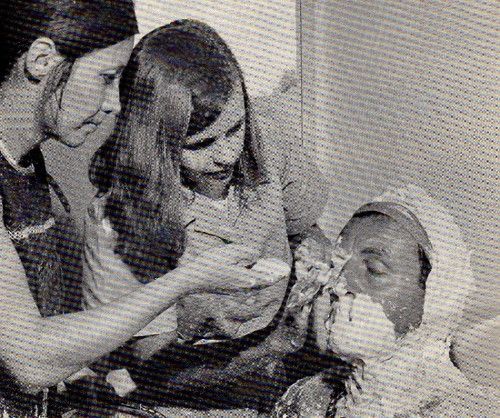
Mrs. B. A. van Blomestein (centre). Display Artist, assisted by Mrs. U. Law, casting human figures for a new display in the Boultbee Gallery. — (Photo: Windsor Studios)
In 1962 the Museum moved to its present modern buildings and only just in time because the white ants had already started on the cases themselves, having worked systematically through the timbers of the building. Many of the original exhibits were the worse for wear and Dr. Broadley describes how he removed thick layers of caked dust from the animal heads and had to patch up the rhino's ear, part of which had been mysteriously cut off. A full time technical officer was not appointed until 1965. Up to this time Dr. Broadley and Captain Boultbee managed with a willing band of part time helpers, and working on a shoestring, to build up a most comprehensive and attractive array of displays ready for the official opening in 1964.
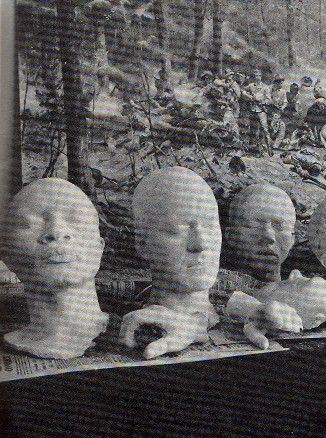
Some of the results — (Photo: Windsor Studios)
From time to time temporary exhibitions are held in the Museum Foyer. The exhibits include material from museum collections or lent by members of the public. As Umtali has no Art Gallery, we provide facilities for art exhibitions such as: the Annual Manicaland Artists' Exhibition, itinerant exhibitions and exhibitions of individual artists' work.
Maintenance and improvement of existing displays goes on continually. The conversion of the Whitehead Gallery into a Lecture Hall will result in the complete reorganisation of the Beit/Mezzanine Area. It is planned to convert this into four or five discrete, intimate galleries for vertebrate zoology, invertebrate zoology, herpetology, archaeology and ethnology. At the moment plans are in hand to add a display of arms and uniforms to the Boultbee Gallery. There is little fear then of the Technical Department being idle in the foreseeable future!

Part of the 3rd Manicaland Artists' Exhibition, one of many Temporary Displays held at the Museum. (Photo: H. D. Jackson)
UMTALI JUNIOR MUSEUM CLUB
G. Watson and B. van Blomestein
Club Organisers
THE Umtali Junior Museum Club is a new venture and is the brainchild of our Curator, Mr. Des Jackson. The first meeting was held in the Beit Gallery on 19th January, 1974, and was attended by over 50 children. Mr. Jackson gave a talk on Nightjars, accompanied by pictures and sound tapes. The morning ended with a film show.
The initial response has been good and our membership continues to grow steadily. We have limited membership to children from Standards four and five, to make for a homogeneous group and to enable us to organise outings and work groups of a manageable number of children.
The club meets once a fortnight (on Saturday mornings) during the school terms. Our meetings include:
1. Filmshows on wildlife, science, travel, people and
places.
2. Talks by members of the Museum staff and other experts.
3. Outings and mini expeditions to such places as Museum field camps, places of historical interest. National Parks, e.g. Murahwa's Hill, mines etc.
4. Demonstrations and work groups involving such processes as taxidermy, modelling and casting, how to make small displays, photography and so on.
5. Competitions for prizes. We hold quizzes, drawing and painting competitions, story competitions and prizes for practical work.
The membership fee is 50c per term. With the membership cards, members have free entry into the Umtali Museum, the National Museum of Bulawayo and the Queen Victoria Museum in Salisbury. Casual visitors are welcome and pay a fee of 10c. Members receive a copy of the monthly Umtali Museum Society Newsletter and we are issuing a separate Junior Club Newsletter once a term, which will include a programme for the following term and articles of interest by Club Members.
We are open to suggestions and would like the Club Members to come forward with ideas. We hope toshow the children what an interesting and diversified place a Museum really is and to spur them on to find out more about the wonderful world around us. During the school holidays we encourage members to write their own nature diaries or accounts of exciting holiday trips, which they illustrate with photographs, pictures, or their own drawings. An exhibition of findings of club members, examples of their work and even live exhibits, will be arranged at the end of the year so that parents and other members of the public can see what the Junior Museum Club is doing. It is planned to hold an open day each year.
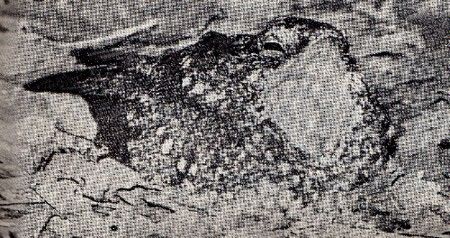
"That's all Folks, hope you enjoyed it!" A young captive Freckled Nightjar (Caprimulgus tristigma) yawning. (Photo: H. D. Jackson)
The Monuments section of the
NATIONAL MUSEUMS AND MONUMENTS OF RHODESIA
housed in the National Museum, Centenary Park, Bulawayo, is the custodian of all monuments and relics throughout the country.

The Conical Tower, the Temple. Zimbabwe National Monument.
Postal Addresses:
NATIONAL MUSEUMS AND MONUMENTS ADMINISTRATION.
P.O. Box 8540. Causeway, Rhodesia.
NATIONAL MUSEUM,
P.O. Box 240, Bulawayo, Rhodesia.
QUEEN VICTORIA MUSEUM.
P.O. Box 8006, Causeway. Rhodesia.
UMTALI MUSEUM,
Victory Avenue, Umtali, Rhodesia.
NATIONAL MONUMENTS,
P.O. Box 3248, Bulawayo, Rhodesia.
The contents are reprinted with permission from Rhodesia Science News, a journal of the Rhodesia Scientific Association.
Reprinted from Rhodesia Science News Vol. 8. No. May. 1974.
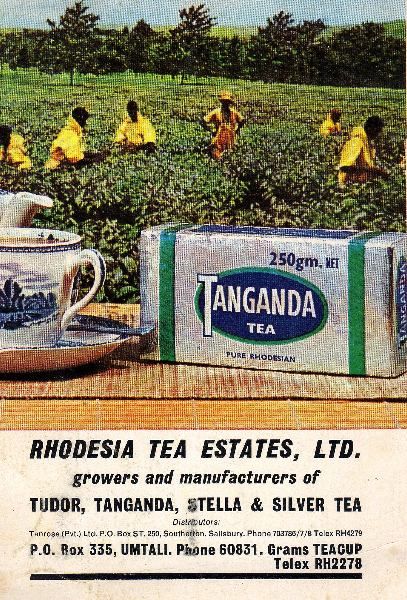
Back Cover
The following advertisement appeared in this publication.
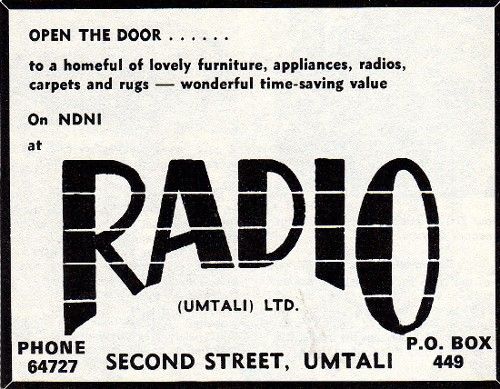



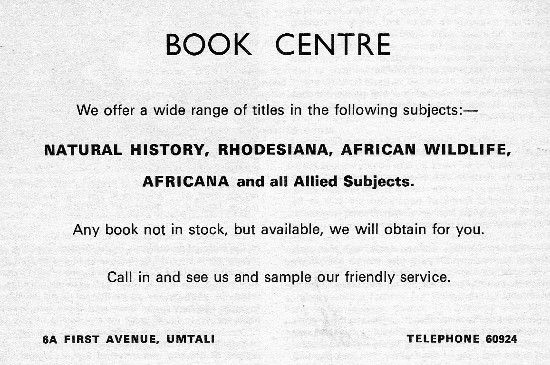
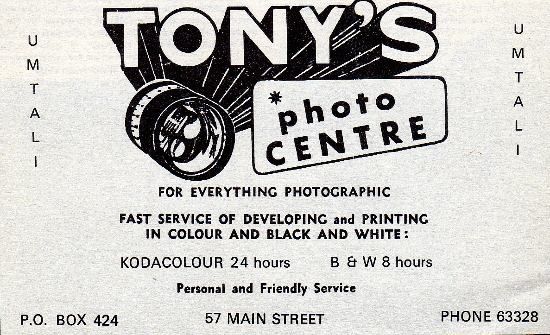
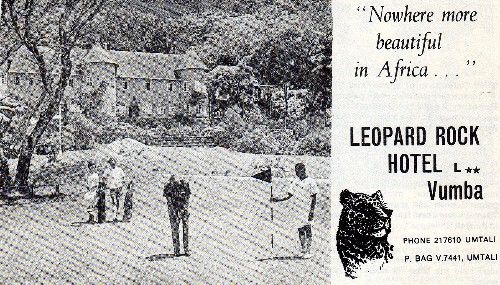
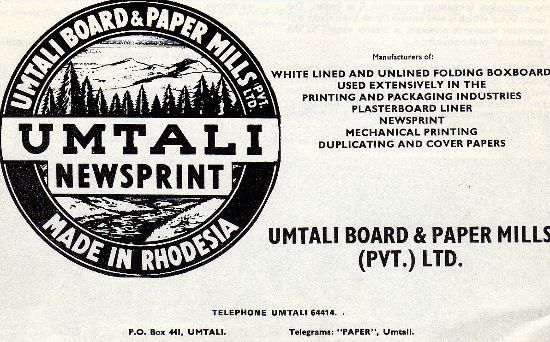
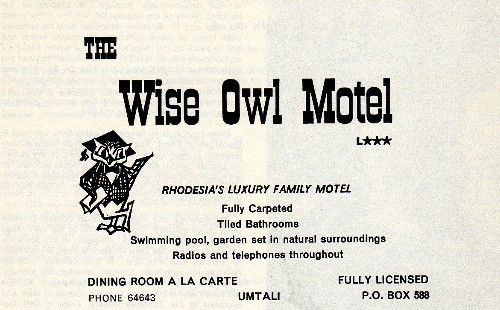



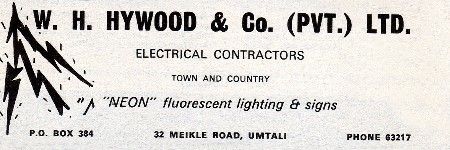

End of publication.
Extracted and recompiled by Eddy Norris for use on 'Our Rhodesian Heritage' blog.
Comments are welcome, please send them to Eddy Norris at orafs11@gmail.com


4 Comments:
Pam Brent (now Schofield) Writes:-
Have just opened the Umtali Museum blog, and enjoyed it as I do with all the info. in the ORAFS newsletters. My connection to Umtali Museum is the fact that my appendix landed up there in 1966! I had my appendix out in Umtali General and it turned out to be exceptionally long! and I was asked by Mr Innes my surgeon if I would let them put it in a jar in the Science section of the Museum. I consented but never plucked up the nerve to go and view it as I thought it was much too gruesome!!!
I also trawled the internet the other day found the Our Story website and found I was on it. I had a picture of myself in the group of prefects for 1969 and then Head Girl at Umtali Girls High School in 1970.
Keep up the good work, always enjoy looking at your articles and especially love your ORAFS motto, definitely encapsulates the Rhodesian Air Force spirit. My son now flies for SAA.
Regards
I used to go the Umtali museum in the 60's and 70's. Mr Roland Pletts was always willing to provide information that kept a young boy's interest. He has remained a family friend to this day.
My aunt Penny (Penny Letley) also worked in the museum. Finding this site was a great surprise.
we offer online financial help to those in need of funds for the following reasons,pay bills,starting of various business,personal funding uilding of home, and other financial needs apply here very easy just email us and your financial problem is solve withing a short period of time with affordable interest rate of 3% contact us now fast and durable funds raising for all email us now jubrinfinance333@gmail.com
Thanks for sharing, nice post! Post really provice useful information!
An Thái Sơn với website anthaison.vn chuyên sản phẩm máy đưa võng hay máy đưa võng tự động tốt cho bé là địa chỉ bán máy đưa võng giá rẻ tại TP.HCM và giúp bạn tìm máy đưa võng loại nào tốt hiện nay.
Post a Comment
Subscribe to Post Comments [Atom]
<< Home